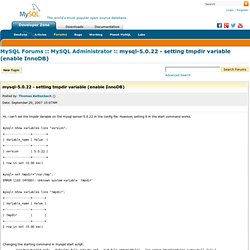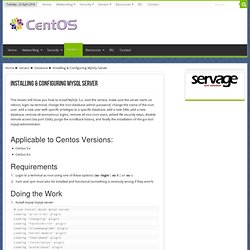

Sql - MySQL incorrect key file for tmp table when making multiple joins. Home. 5.0.22 - setting tmpdir variable (enable InnoDB) Hi, i can't set the tmpdir Variable on the mysql-server-5.0.22 in the config file.

However, setting it in the start command works. mysql> show variables like "version"; +---------------+--------+ | Variable_name | Value | +---------------+--------+ | version | 5.0.22 | +---------------+--------+ 1 row in set (0.00 sec) mysql> set tmpdir="/var/tmp"; ERROR 1193 (HY000): Unknown system variable 'tmpdir' mysql> show variables like "tmpdir"; +---------------+-------+ | Variable_name | Value | +---------------+-------+ | tmpdir | | +---------------+-------+ 1 row in set (0.00 sec) Changing the starting command in mysqld start script: /usr/bin/mysqld_safe --defaults-file=/etc/my.cnf --pid-file="$mypidfile" --log-error="$errlogfile" >/dev/null 2>&1 & to: /usr/bin/mysqld_safe --defaults-file=/etc/my.cnf --pid-file="$mypidfile" --log-error="$errlogfile" --tmpdir=/var/tmp >/dev/null 2>&1 & works.
Interactive mysql shows: Setting the tmpdir Variable in the my.cnf file also does not work. my.cnf: 17.2 MySQL Cluster Installation and Upgrades. How to Install MySQL Database Using Yum groupinstall on CentOS. In this article, let us review how to install MySQL on CentOS using yum.

Instead of searching and installing mysql and related packages one-by-one, it is better to install MySQL using yum groups. If you are interested in installing the full LAMP stack, refer to our earlier article on how to install/upgrade LAMP using yum. 1. Identify the Group name of MySQL Packages yum grouplist displays all package groups that are available in the repository.
. # yum grouplist | grep -i mysql MySQL Database 2. Yum groupinfo displays all the packages that are bundled in a group. As shown below, “MySQL Database” group contains 1 mandatory package, 6 default packages, and 5 optional packages. # yum groupinfo "MySQL Database" Group: MySQL Database Description: This package group contains packages useful for use with MySQL. 3. Yum groupinstall will install the “MySQL Database” group of packages as shown below. 4. Execute rpm -qa, to confirm that the mysql related packages are installed. Installing & Configuring MySQL Server. This Howto will show you how to install MySQL 5.x, start the service, make sure the server starts on reboot, login via terminal, change the root database admin password, change the name of the root user, add a new user with specific privileges to a specific database, add a new DBA, add a new database, remove all anonymous logins, remove all non-root users, added file security steps, disable remote access (via port 3306), purge the scrollback history, and finally the installation of the gui tool mysql-administrator.

Applicable to Centos Versions: Centos 5.xCentos 6.x Requirements Login to a terminal as root using one of these options: (su –login | su -l | or: su -)Yum and rpm must also be installed and functional (something is seriously wrong if they aren’t) Doing the Work Install mysql mysql-server: Start MySQL server daemon (mysqld): Login as root database admin to MySQL server: # mysql -u root Welcome to the MySQL monitor. Delete ALL users who are not root: Add a MySQL database: Troubleshooting. MySQL Change root Password. How do I change MySQL root password under Linux, FreeBSD, OpenBSD and UNIX-like like operating system over the ssh session?
Setting up MySQL password is one of the essential tasks. By default, root user is MySQL admin account user.